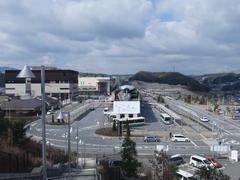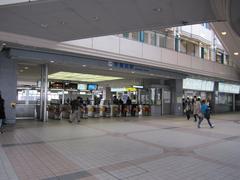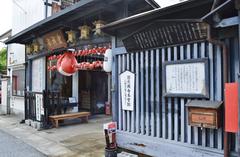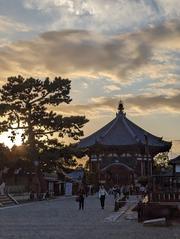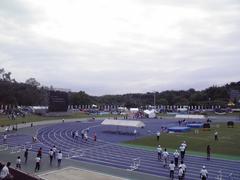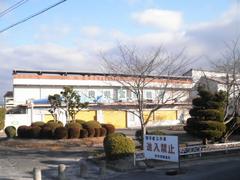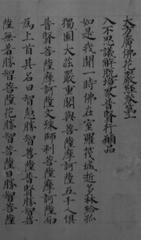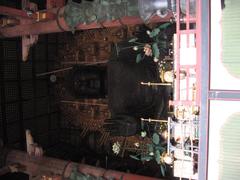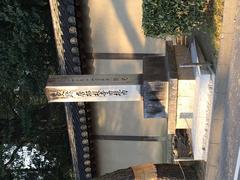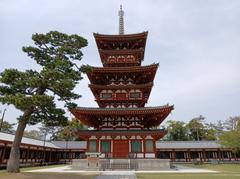
Hannya-ji Visiting Hours, Tickets, and Nara Historical Sites Guide
Date: 04/07/2025
Introduction
Hannya-ji Temple (般若寺), nestled in the historic city of Nara, Japan, is a serene sanctuary that exemplifies over a millennium of Buddhist heritage, architectural mastery, and seasonal beauty. Celebrated as the “Cosmos Temple” for its dazzling autumn blooms, Hannya-ji offers a tranquil alternative to Nara’s more visited landmarks such as Tōdai-ji or Kōfuku-ji. Its storied past—dating back to 629 CE and linked to the monk Ekan from Goguryeo—reflects a deep connection to Japan’s imperial and spiritual history (Nara City Tourism Association; JP Manual).
This comprehensive guide covers Hannya-ji’s origins, architectural highlights, practical visitor information, and tips for exploring one of Nara’s most treasured historical sites. Whether you’re seeking spiritual insight, architectural inspiration, or a peaceful retreat surrounded by seasonal blooms, Hannya-ji invites you into the heart of Japan’s cultural legacy (touristplaces.guide; washokuclub.com).
Contents
- Discover Hannya-ji: A Tranquil Historical Gem
- Historical Overview
- Origins and Early History
- Imperial Patronage and Protective Role
- Medieval Turmoil and the Genpei War
- Architectural and Cultural Treasures
- Rōmon Gate (National Treasure)
- Hondō (Main Hall)
- Kyōzō (Sutra Repository)
- 13-Storey Stone Pagoda
- Kasatoba (Stone Stupa)
- Shōrō (Bell Tower)
- Memorials and Historical Figures
- Hannya-ji’s Place in Nara’s Cultural Landscape
- Practical Visitor Information
- Access, Hours, and Tickets
- Accessibility
- Best Times to Visit
- Seasonal Attractions and Events
- Tips for Visiting
- Nearby Attractions
- Frequently Asked Questions (FAQ)
- Summary & Visitor Tips
- Official Sources
Discover Hannya-ji: A Tranquil Historical Gem
Located in northern Nara, Hannya-ji Temple is renowned for its tranquil atmosphere, elegant architecture, and vibrant displays of seasonal flowers. The temple offers visitors an intimate experience with Japanese spiritual and cultural traditions, set against a backdrop of serene gardens and panoramic city views (Japan Travel).
Historical Overview
Origins and Early History
Founded in 629 CE by Ekan, a monk from Goguryeo, Hannya-ji’s roots are entwined with the formative years of Japanese Buddhism. While temple lore claims this early date, the first documented reference appears in 742 CE within the Shōsōin archives, affirming its presence in the Nara period (Nara City Tourism Association; Wikipedia). The temple’s name comes from the Sanskrit “prajñā” (“wisdom”), and its principal deity, Monju Bosatsu (Manjushri Bodhisattva), embodies this virtue (JP Manual).
Imperial Patronage and Protective Role
Emperor Shōmu’s patronage in the 8th century elevated Hannya-ji’s status, notably with the donation of sacred Buddhist scriptures and the construction of a stupa to safeguard the capital. Strategically located northeast of Heijō-kyō (ancient Nara), the temple was established to guard the city’s “demon gate” (kimon), a direction believed to require spiritual protection (Wikipedia; Nara City Tourism Association).
Medieval Turmoil and the Genpei War
The Genpei War (1180–1185) brought devastation to Nara, and Hannya-ji was not spared. In 1180, the temple suffered destruction by fire during attacks led by Taira no Shigehira, as chronicled in “The Tale of the Heike.” Despite such turmoil, the temple was rebuilt, and its legacy endured (Wikipedia).
Architectural and Cultural Treasures
Rōmon Gate (National Treasure)
Hannya-ji’s two-story Rōmon gate, dating from the late Kamakura period, is a designated National Treasure. Its unique structure features a single ground-level entrance and a three-bay upper story, making it an architectural rarity (JP Manual). The gate marks the threshold from the secular world to sacred space.
Hondō (Main Hall)
The main hall, rebuilt in 1667, is a Prefectural Cultural Property. Inside stands the revered statue of Monju Bosatsu, accompanied by attendant figures and ceremonial offerings (JP Manual).
Kyōzō (Sutra Repository)
Housing a complete collection of Buddhist scriptures, the Kyōzō dates to the Kamakura period and is recognized as an Important Cultural Property.
13-Storey Stone Pagoda
This impressive medieval pagoda, the tallest of its kind in Japan, stands before the main hall and serves as a symbol of Buddhist wisdom (2ponderful.com).
Kasatoba (Stone Stupa) and Shōrō (Bell Tower)
Other significant structures include the Kasatoba stupa and the 1694 Shōrō bell tower, both contributing to the temple’s historical ambiance.
Memorials and Historical Figures
Hannya-ji’s temple grounds feature memorials to Imperial Prince Otonomiya Moriyoshi and Fujiwara no Yorinaga, reflecting its longstanding ties to Japan’s imperial and samurai history (JP Manual).
Hannya-ji’s Place in Nara’s Cultural Landscape
As part of Nara’s extensive network of ancient temples, Hannya-ji offers a quieter, more contemplative experience than the city’s major tourist attractions. Its seasonal flower events, particularly the cosmos bloom in autumn and hydrangeas in early summer, have earned it the affectionate title of “Cosmos Temple” (Japan Travel).
Practical Visitor Information
- Location: 221 Hannyajicho, Nara, 630-8102, Japan (Google Maps)
- Hours: 9:00 AM – 5:00 PM (last admission 4:30 PM). Hours may extend during special events.
- Admission: 400–500 yen for adults, discounts for children and groups. Tickets are available onsite.
- Access: From Nara Station, take a bus to “Aoyama jutaku” or “Kunimidai 8-chome”; alight at Hannya-ji stop, then 10 minutes on foot (JP Manual).
- Parking: Available (500 yen during cosmos season).
- Accessibility: Most grounds are wheelchair accessible, though some areas have uneven surfaces. Assistance is available if needed.
- Best Time to Visit: Late September–early November (cosmos flowers); early summer (hydrangeas).
Seasonal Attractions and Events
Cherry Blossoms (Late March – Early April)
Centuries-old cherry trees create a peaceful hanami (flower viewing) spot, with fewer crowds than central Nara.
Summer Greens
Lush gardens and mosses provide a tranquil atmosphere, perfect for meditation and relaxation.
Cosmos Festival (Late September – Early November)
The temple’s signature event features over 150,000 cosmos flowers in vibrant colors, drawing visitors from across Japan (2ponderful.com).
Autumn Foliage (Late October – Mid-November)
Maple and ginkgo trees turn brilliant shades, offering spectacular photo opportunities.
Tips for Visiting
- Photography: Best light is early morning or late afternoon. Tripod use may be restricted during peak seasons.
- Etiquette: Maintain silence in prayer halls and respect posted guidelines.
- Souvenirs: Collect a goshuin (temple seal) as a unique memento.
- Guided Tours: Periodic tours and audio guides are available for deeper insight (washokuclub.com).
Nearby Attractions
- Tōdai-ji: Home to the Great Buddha statue.
- Kōfuku-ji: Famous for its five-story pagoda.
- Nara Park: Known for its friendly deer and walking paths.
- Naramachi District: Traditional merchant houses and historic streets.
Frequently Asked Questions (FAQ)
Q: What are Hannya-ji’s visiting hours?
A: 9:00 AM to 5:00 PM, last admission at 4:30 PM.
Q: How much are the tickets?
A: 400–500 yen for adults; discounts for children and groups.
Q: Is the temple accessible for visitors with disabilities?
A: Most areas are accessible, though some uneven paths may require assistance.
Q: Are guided tours available?
A: Yes, check the official website or tourism centers for schedules.
Q: When is the best time to visit?
A: During the cosmos bloom in autumn or cherry blossom season in spring.
Summary & Visitor Tips
Hannya-ji Temple stands as a living monument to Nara’s Buddhist legacy, offering visitors a harmonious blend of spiritual depth, architectural beauty, and seasonal wonders. Its National Treasure Rōmon gate, impressive stone pagoda, and tranquil gardens provide a rich cultural experience enhanced by practical accessibility and proximity to other notable Nara landmarks. Plan your visit to coincide with seasonal events for the most memorable views, and consider exploring nearby historic sites to enrich your journey (JP Manual; Japan Travel; Nara City Tourism Association).
For the latest updates, guided tour information, and seasonal event schedules, consult official resources and consider travel apps like Audiala for personalized guidance.
Sources and Official Links
- Nara City Tourism Association
- Wikipedia
- JP Manual
- 2ponderful.com
- touristplaces.guide
- washokuclub.com
- sparkle.travel
- Japan Travel






